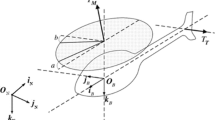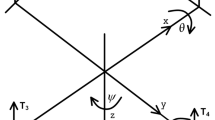Abstract
This paper presents a novel multi-variable high-order sliding mode quasi-optimal control method for unmanned helicopters. In order to facilitate the theoretical design and engineering implementation, the control system is divided into attitude and position subsystem, and the latter is further subdivided into two parts, horizontal and vertical position control. Then the multi-variable adaptive high-order continuous sliding mode controllers are designed for attitude and position, respectively, based on integral sliding mode surface. A new quadratic performance index is proposed in the design process, which enables the control system to converge in finite time, and the convergence rate can be adjusted by control parameters. Finally, the effectiveness and robustness of the proposed method are verified and compared with existing literature by simulation and practical experiments. The comparison results show that the proposed method has higher tracking accuracy and better robustness.



















Similar content being viewed by others
Data Availibility Statement
The datasets generated during and/or analysed during the current study are available from the corresponding author on reasonable request.
References
Ahmed, B., Pota, H.R., Garratt, M.: Flight control of a rotary wing uav–a practical approach. In: IEEE Conference on Decision and Control (2008)
Bhat, S.P., Bernstein, D.S.: Geometric homogeneity with applications to finite-time stability. Math. Control Signals Syst. 17(2), 101–127 (2005)
Bin, X., Jianchuan, G., Yao, Z.: Adaptive backstepping tracking control of a 6-dof unmanned helicopter. IEEE/CAA J. Autom. Sinica 2(1), 19–24 (2015)
Cisneros, P.S.G., Hoffmann, C., Bartels, M., Werner, H.: Linear parameter-varying controller design for a nonlinear quad-rotor helicopter model for high speed trajectory tracking. In: 2016 American Control Conference (ACC), pp. 486–491 (2016)
Ding, S., Mei, K., Yu, X.: Adaptive second-order sliding mode control: a lyapunov approach. IEEE Trans. Autom. Control (2021). https://doi.org/10.1109/TAC.2021.3115447
El-Ferik, S., Syed, A.H., Omar, H.M., Deriche, M.A.: Nonlinear forward path tracking controller for helicopter with slung load. Aerosp. Sci. Technol. 69, 602–608 (2017)
Fang, X., Wu, A., Shang, Y., Dong, N.: A novel sliding mode controller for small-scale unmanned helicopters with mismatched disturbance. Nonlinear Dyn 83(1), 1053–1068 (2016)
Fang, X., Wu, A., Shang, Y., Dong, N.: Robust control of small-scale unmanned helicopter with matched and mismatched disturbances. J. Franklin Inst. 353(18), 4803–4820 (2016)
Fang, Z., Tian, H., Li, P.: Probabilistic robust linear parameter-varying control of a small helicopter using iterative scenario approach. IEEE/CAA J. Autom. Sinica 2(1), 85–93 (2015)
Filippov, A.F.: Differential Equations with Discontinuous Right-hand Side. Kluwer, Dordrecht, The Netherlands (1998)
Frost, W., Turner, R.E.: A discrete gust model for use in the design of wind energy conversion systems. J. Appl. Meteorol. 21(6), 770–776 (1982)
Godbolt, B., Vitzilaios, N.I., Lynch, A.F.: Experimental validation of a helicopter autopilot design using model-based pid control. Journal of Intelligent and Robotic Systems 70(1), 385–399 (2013)
Halbe, O., Hajek, M.: Robust helicopter sliding mode control for enhanced handling and trajectory following. Journal of Guidance, Control, and Dynamics 43(10), 1805–1821 (2020)
He, Y., Pei, H., Sun, T.: Robust tracking control of helicopters using backstepping with disturbance observers. Asian Journal of Control 16(5), 1387–1402 (2015)
Hua, C., Chen, J., Guan, X.: Fractional-order sliding mode control of uncertain quavs with time-varying state constraints. Nonlinear Dynamics 95(2), 1347–1360 (2019)
Huang, Y., Zhu, M., Zheng, Z., Feroskhan, M.: Fixed-time autonomous shipboard landing control of a helicopter with external disturbances. Aerospace Science and Technology 84, 18–30 (2019)
Jafar, A., Bhatti, A.I., Ahmad, S., Ahmed, N.: Robust gain-scheduled linear parameter-varying control algorithm for a lab helicopter: A linear matrix inequality-based approach. Proceedings of the Institution of Mechanical Engineers, Part I: Journal of Systems and Control Engineering 232(5), 558–571 (2018)
Jiang, T., Lin, D., Song, T.: Finite-time control for small-scale unmanned helicopter with disturbances. Nonlinear Dynamics 96(3), 1747–1763 (2019)
Kumar, M.V., Omkar, S.N., Suresh, S., Sampath, P., Ganguli, R.: Design of a stability augmentation system for a helicopter using lqr control and ads-33 handling qualities specifications. Aircraft Engineering and Aerospace Technology 80(2), 111–123 (2008)
Liu, H., Derawi, D., Kim, J., Zhong, Y.: Robust optimal attitude control of hexarotor robotic vehicles. Nonlinear Dynamics 74(4), 1155–1168 (2013)
Lu, H., Liu, C., Guo, L., Chen, W.H.: Flight control design for small-scale helicopter using disturbance-observer-based backstepping. Journal of Guidance, Control, and Dynamics 38(11), 2235–2240 (2015)
Lv, M., De Schutter, B., Shi, C., Baldi, S.: Logic-based distributed switching control for agents in power-chained form with multiple unknown control directions. Automatica 137, 110,143 (2022). https://doi.org/10.1016/j.automatica.2021.110143
Lv, M., Yu, W., Cao, J., Baldi, S.: Consensus in high-power multiagent systems with mixed unknown control directions via hybrid nussbaum-based control. IEEE Transactions on Cybernetics (2020). https://doi.org/10.1109/TCYB.2020.3028171
Lv, M., Yu, W., Cao, J., Baldi, S.: A separation-based methodology to consensus tracking of switched high-order nonlinear multiagent systems. IEEE transactions on neural networks and learning systems (2021). https://doi.org/10.1109/TNNLS.2021.3070824
Mahmoud, M.S., Koesdwiady, A.B.: Improved digital tracking controller design for pilot-scale unmanned helicopter. Journal of the Franklin Institute 349(1), 42–58 (2012)
Maqsood, H., Qu, Y.: Nonlinear disturbance observer based sliding mode control of quadrotor helicopter. Journal of Electrical Engineering & Technology 15(3), 1453–1461 (2020)
Masajedi, P., Ghanbarzadeh, A.: Optimal controller designing based on linear quadratic regulator technique for an unmanned helicopter at hover with the presence of wind disturbance. International Journal of Dynamics and Control 1(3), 214–222 (2013)
Raptis, I.A., Valavanis, K.P., Moreno, W.A.: A novel nonlinear backstepping controller design for helicopters using the rotation matrix. IEEE Transactions on Control Systems Technology 19(2), 465–473 (2011)
Sandino, L.A., Bejar, M., Kondak, K., Ollero, A.: Advances in modeling and control of tethered unmanned helicopters to enhance hovering performance. Journal of Intelligent & Robotic Systems 73(1–4), 3–18 (2014)
Thomas, F., Thottungal, A.V., Johnson, M.S.: Composite control of a hovering helicopter based on optimized sliding mode control. Journal of Optimization Theory and Applications pp. 1–20 (2021)
Tijani, I.B., Akmeliawati, R., Legowo, A., Budiyono, A.: robust controller for autonomous helicopter hovering control. Aircraft Engineering & Aerospace Technology 87(4), 330–344 (2015)
Tijani, I.B., Akmeliawati, R., Legowo, A., Budiyono, A., Muthalif, A.A.: robust controller for autonomous helicopter hovering control. Aircraft Engineering & Aerospace Technology 83(6), 363–374 (2011)
Wang, B., Shen, Y., Zhang, Y.: Active fault-tolerant control for a quadrotor helicopter against actuator faults and model uncertainties. Aerospace Science and Technology 99, 105,745 (2020)
Wang, D., Zong, Q., Tian, B., Lu, H., Wang, J.: Adaptive finite-time reconfiguration control of unmanned aerial vehicles with a moving leader. Nonlinear Dynamics 95(2), 1099–1116 (2019)
Wang, H.Q., Mian, A.A., Wang, D.B., Duan, H.B.: Robust multi-mode flight control design for an unmanned helicopter based on multi-loop structure. International Journal of Control Automation & Systems 7(5), 723–730 (2009)
Wang, T., Yang, C., Liang, J., Wu, Y., Wang, C., Zhang, Y.: Chaos-genetic algorithm for the system identification of a small unmanned helicopter. Journal of Intelligent & Robotic Systems 67(3–4), 323–338 (2012)
Yang, J.H., Hsu, W.C.: Adaptive backstepping control for electrically driven unmanned helicopter. Control Engineering Practice 17(8), 903–913 (2009)
Yu, X., Yang, J., Li, S.: Disturbance observer-based autonomous landing control of unmanned helicopters on moving shipboard. Nonlinear Dynamics 102(1), 131–150 (2020)
Zhao, Z., Cao, D., Yang, J., Wang, H.: High-order sliding mode observer-based trajectory tracking control for a quadrotor uav with uncertain dynamics. Nonlinear Dynamics 102(4), 2583–2596 (2020)
Zhong, Y.: Optimal Control. Tsinghua University Press, Beijing (2015)
Zhou, B., Li, Z., Zheng, Z., Tang, S.: Nonlinear adaptive tracking control for a small-scale unmanned helicopter using a learning algorithm with the least parameters. Nonlinear Dynamics 89(2), 1289–1308 (2017)
Zhou, B., Lu, X., Tang, S., Zheng, Z.: Nonlinear system identification and trajectory tracking control for a flybarless unmanned helicopter: theory and experiment. Nonlinear Dynamics 96(4), 2307–2326 (2019)
Zhu, B., Huo, W.: 3-d path-following control for a model-scaled autonomous helicopter. IEEE Transactions on Control Systems Technology 22(5), 1927–1934 (2014)
Zou, Y., Zheng, Z.: A robust adaptive rbfnn augmenting backstepping control approach for a model-scaled helicopter. IEEE Transactions on Control Systems Technology 23(6), 2344–2352 (2015)
Acknowledgements
The author of this paper owes great thanks to Mr. Xuanying Li for his disinterested assistance in outdoor flight experiments. Moreover, the author would like to express sincere gratitude to the Editor and the anonymous reviewers whose insightful comments have helped to improve the quality of this paper considerably.
Funding
The authors have no relevant financial or non-financial interests to disclose. All authors certify that they have no affiliations with or involvement in any organization or entity with any financial interest or non-financial interest in the subject matter or materials discussed in this manuscript.The authors have no financial or proprietary interests in any material discussed in this article. The authors have no financial or proprietary interests in any material discussed in this article.
Author information
Authors and Affiliations
Corresponding author
Ethics declarations
Conflict of interest
The authors declare that they have no conflict of interest.
Ethical approval
This article does not contain any studies with human participants or animals performed by any of the authors.
Informed consent
Informed consent was obtained from all individual participants included in the study.
Additional information
Publisher's Note
Springer Nature remains neutral with regard to jurisdictional claims in published maps and institutional affiliations.
Appendix
Appendix
Lemma 4
([40]). Assuming that \(\left( \varvec{A}_\mathrm {n} , \varvec{B}_\mathrm {n}\right) \) is stabilized and \(\left( \varvec{A}_\mathrm {n} , \varvec{D}\right) \) is detectable, then the linear time-invariant infinite time LQR optimal control is asymptotically stable. If \(\left( \varvec{A}_\mathrm {n} , \varvec{D}\right) \) is observable, then the solution \( \bar{\varvec{P}} \) of the Riccati matrix algebraic equation (117) is positive definite.
\(\square \)
Proof of Lemma 2
Since matrix \(\left( \varvec{A}_\mathrm {n}+ \delta {{{\varvec{I}}_{ln \times ln}}}, \varvec{B}_\mathrm {n}\right) \) is stabilized and \(\left( \varvec{A}_\mathrm {n}+ \delta {{{\varvec{I}}_{ln \times ln}}}, \varvec{D} \right) \) is detectable, according to Lemma 4, for the linear time-invariant infinite time LQR problem described by system (36) and performance index (37), the optimal control is given by equation (38), then the system (36) is asymptotically stable. In other words, \({\bar{\varvec{z}}}(t)\) is bounded and asymptotically approaches zero. Thus,
That’s to say, the state \( {{\varvec{z}}}(t) \) converges to the origin at a rate no less than the exponential function \(e^{-\delta t} \). \(\square \)
Rights and permissions
About this article
Cite this article
Zhou, B. Multi-variable adaptive high-order sliding mode quasi-optimal control with adjustable convergence rate for unmanned helicopters subject to parametric and external uncertainties. Nonlinear Dyn 108, 3671–3692 (2022). https://doi.org/10.1007/s11071-022-07433-3
Received:
Accepted:
Published:
Issue Date:
DOI: https://doi.org/10.1007/s11071-022-07433-3




